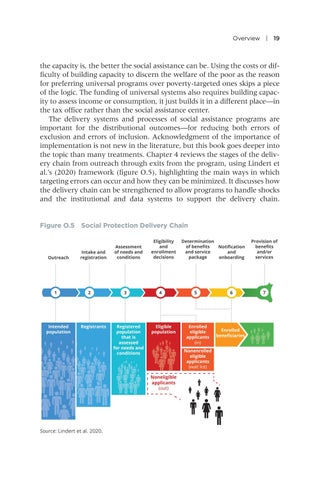Overview | 19
the capacity is, the better the social assistance can be. Using the costs or difficulty of building capacity to discern the welfare of the poor as the reason for preferring universal programs over poverty-targeted ones skips a piece of the logic. The funding of universal systems also requires building capacity to assess income or consumption, it just builds it in a different place—in the tax office rather than the social assistance center. The delivery systems and processes of social assistance programs are important for the distributional outcomes—for reducing both errors of exclusion and errors of inclusion. Acknowledgment of the importance of implementation is not new in the literature, but this book goes deeper into the topic than many treatments. Chapter 4 reviews the stages of the delivery chain from outreach through exits from the program, using Lindert et al.’s (2020) framework (figure O.5), highlighting the main ways in which targeting errors can occur and how they can be minimized. It discusses how the delivery chain can be strengthened to allow programs to handle shocks and the institutional and data systems to support the delivery chain.
Figure O.5 Social Protection Delivery Chain
Outreach
1
Intended population
Intake and registration
2
Registrants
Assessment of needs and conditions
3
Registered population that is assessed for needs and conditions
Eligibility and enrollment decisions
4
Eligible population
5
Enrolled eligible applicants (in) Nonenrolled eligible applicants (wait list)
Noneligible applicants (out)
Source: Lindert et al. 2020.
Determination of benefits Notification and service and package onboarding
6
Enrolled beneficiaries
Provision of benefits and/or services
7


